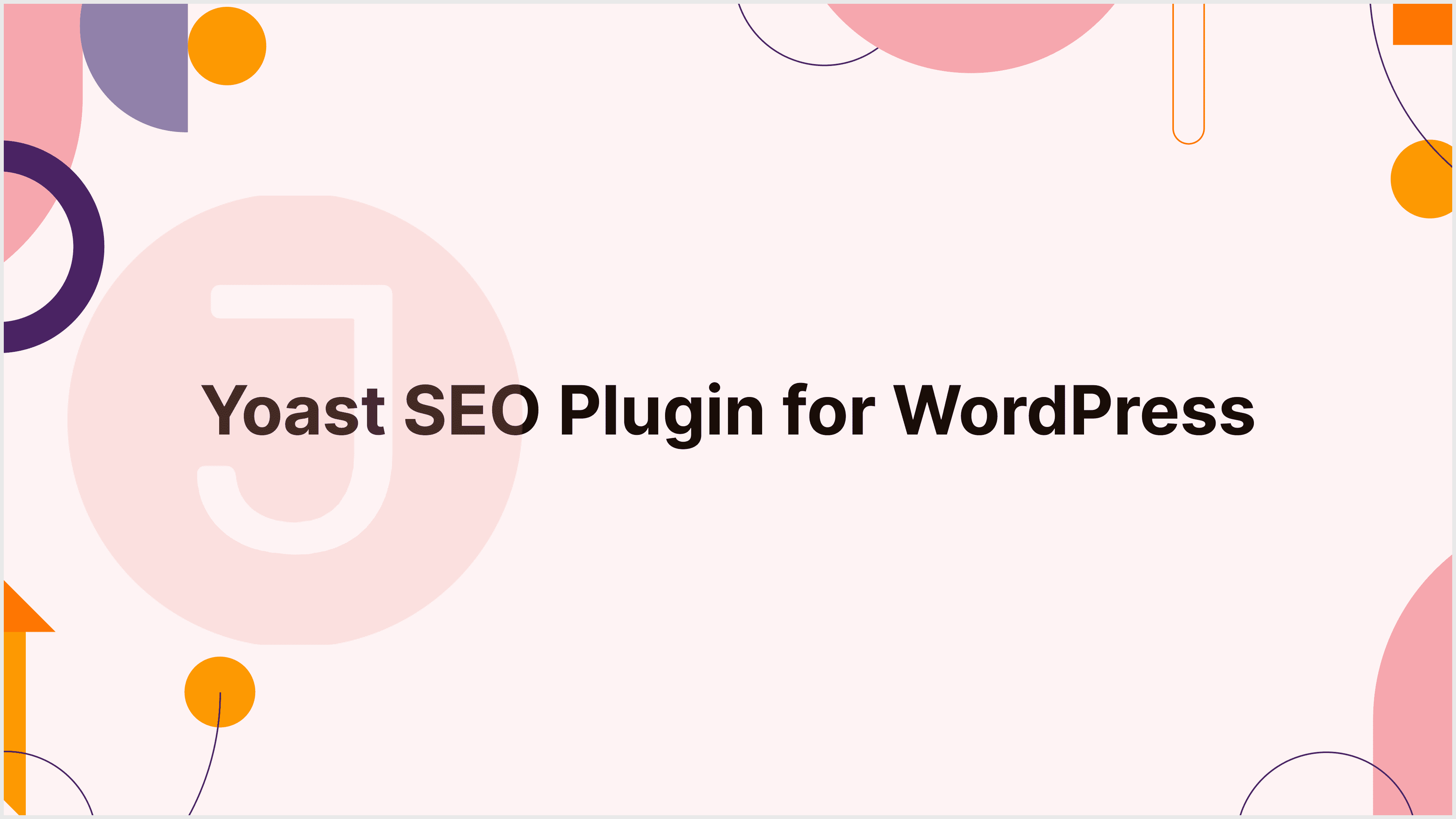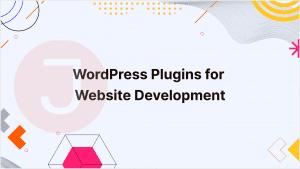WordPress, the world’s most popular content management system (CMS), has a large number of plugins that extend its functionality. From SEO optimization to e-commerce solutions, the options are practically limitless. Yoast SEO, for example, has a superb reputation for its SEO capabilities. It’s the best SEO plugin for WordPress. In this detailed guide, we will delve into the realm of Yoast SEO, looking at its features, benefits, installation procedure, and recommended practices. By the end of this blog, you’ll have a solid understanding of why Yoast SEO is an essential tool for any website owner trying to boost their online visibility.
Table of Contents
What is Yoast SEO?
Joost de Valk built Yoast SEO, a WordPress plugin aimed at optimizing webpages for search engines, primarily Google. With over 5 million active installs, it is widely regarded as the go-to tool for on-page SEO. The plugin is offered in two versions: free and premium, with the latter including more advanced capabilities.
Yoast SEO offers vital insights into your content and simplifies on-page SEO for beginners. It provides real-time analysis and comments on how well your content is optimized for search engines, allowing you to increase your website’s exposure in search engine results pages (SERPs).
Features of Yoast SEO
Yoast SEO is feature-rich and provides a wealth of options for optimizing your website’s SEO. Let’s look at some of its important features:
A. On-Page SEO Analysis
One of the most important aspects of Yoast SEO is its on-page SEO analysis. When you create or edit a post or page, Yoast SEO examines the content and makes suggestions to improve its SEO. These recommendations address a variety of issues, including:
- Keyword optimization: Yoast SEO determines whether you have effectively employed your target keyword throughout the article.
- Readability: It evaluates the readability of your material and provides ways to make it more accessible to your audience.
- Content length: Yoast SEO makes recommendations about the length of your content to help you build well-rounded articles.
- Meta tags: The plugin helps you create SEO-friendly meta titles and descriptions to increase click-through rates.
- Internal and external links: It examines the use of links in your content and recommends adding internal and external links as needed.
B. Readability Analysis
In addition to on-page SEO, Yoast SEO emphasizes text readability. This is essential for engaging your readers and making your material user-friendly. The plugin offers input on the following aspects:
- Sentence and paragraph length: To improve the reading experience, Yoast SEO recommends using proper sentence and paragraph lengths.
- Subheadings: It encourages the use of subheadings to separate text and make it easier to scan.
- Transition words: The plugin suggests utilizing transition words to improve the flow of your material.
C. XML Sitemaps
Yoast SEO automatically builds XML sitemaps, which are required by search engines to crawl and index your website properly. These sitemaps give a clear framework for your site’s content, which helps search engines comprehend and rank your pages. To access your sitemap, go to “SEO” in your WordPress dashboard and click on “General.”
D. Breadcrumbs
Breadcrumbs are a navigational tool that helps users and search engines comprehend the structure of your website. Yoast SEO lets you enable breadcrumbs, which appear in search results and help users browse your site more efficiently.
E. Canonical URLs
Duplicate material can hurt your SEO efforts. Yoast SEO addresses this issue by allowing you to provide canonical URLs, which indicate the preferable version of a page when there are many versions with comparable content. This helps search engines figure out which pages to index and display in search results.
F. Open Graph and Twitter Card Integration
Yoast SEO makes it easier to configure social media metadata on networks such as Facebook and Twitter. It enables you to provide custom photos, titles, and descriptions for when your material is shared on social media, resulting in a polished appearance in social posts.
Installing Yoast SEO
Yoast SEO installation is a basic process. It may be done just from your WordPress dashboard. This is how you do it:
Step 1: Log in to your WordPress dashboard.

Step 2: Click on “Plugins” in the left sidebar and click on “Add New”.
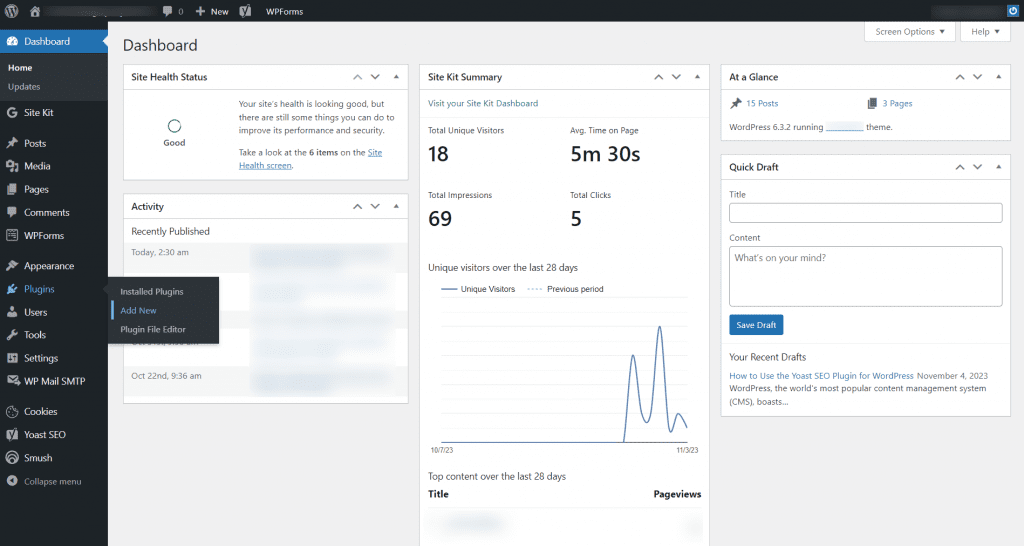
Step 3: In the search bar, type “Yoast SEO.”
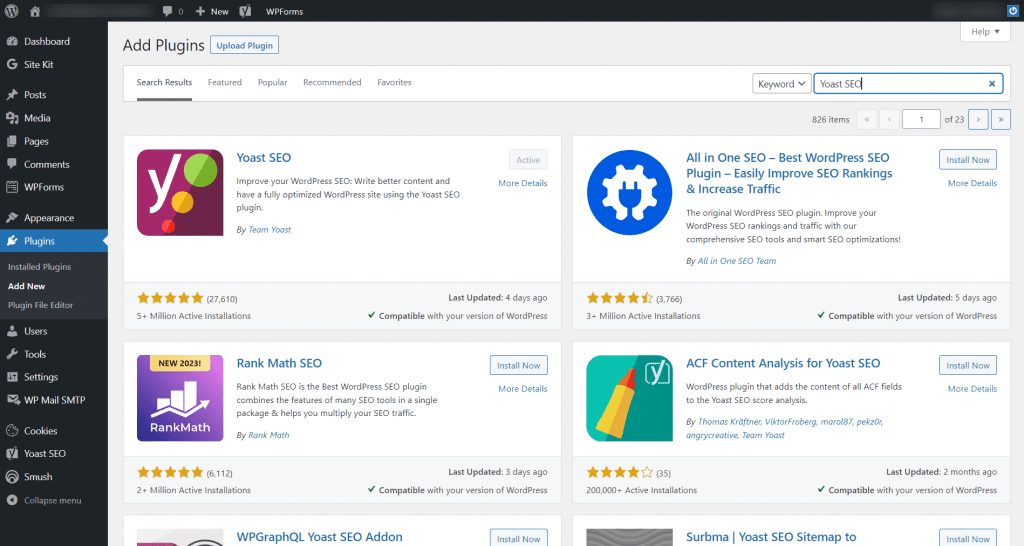
Step 4: You’ll see the Yoast SEO plugin in the search results. Click “Install Now.”
Step 5: Once the installation is complete, click “Activate.”
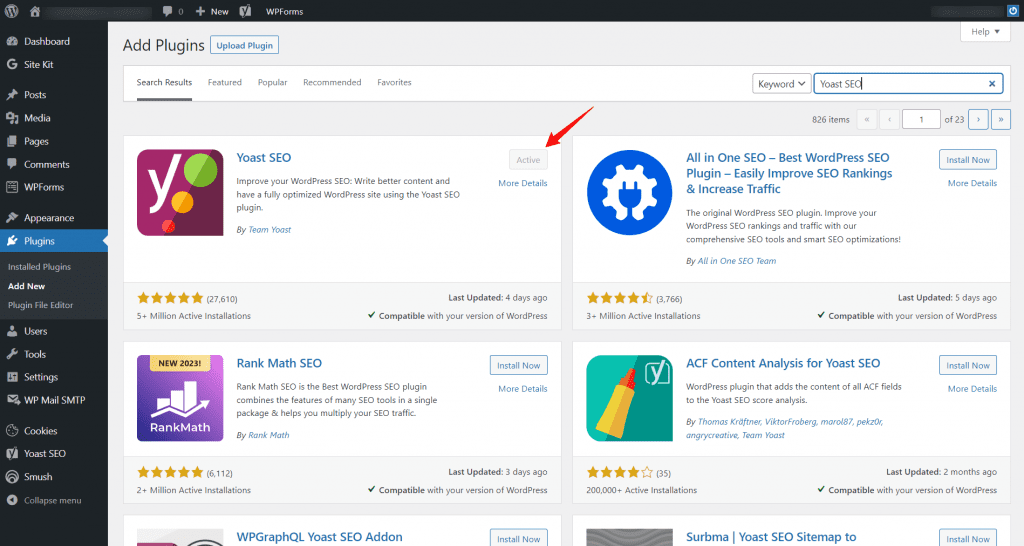
Step 6: You’ll now find the “SEO” option in your dashboard menu.
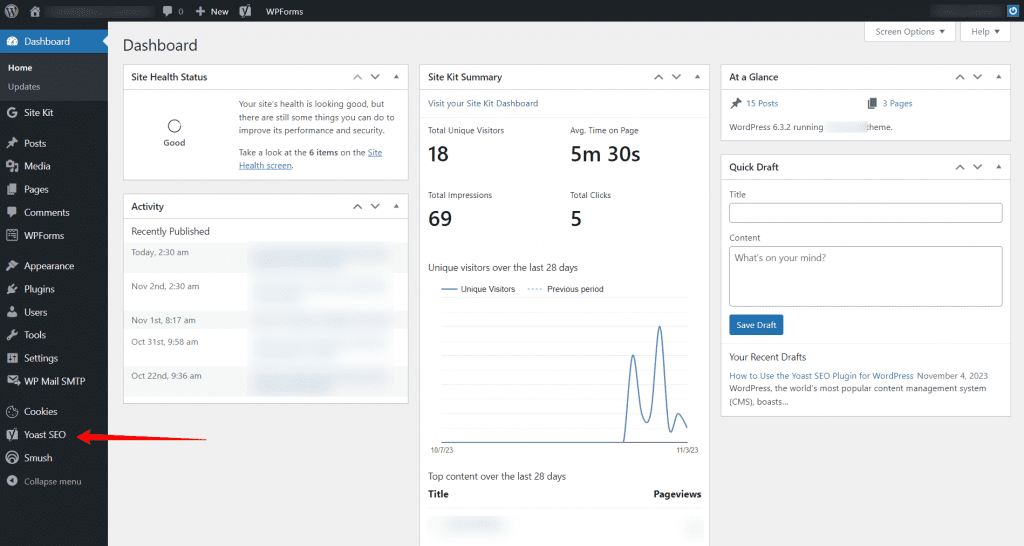
Configuring Yoast SEO
After installing Yoast SEO, it’s critical to customize it to meet your needs. The plugin includes several parameters for customizing your SEO approach. Let us go through the important sections.
A. General Settings
- Titles & Metas: This is where you may change the way your content’s titles and meta descriptions display in search results. You can create templates for a variety of content kinds, including posts, pages, and archives.
- Webmaster Tools: You can add verification codes for a variety of webmaster tools, including Google Search Console and Bing Webmaster Tools.
- Security: Enable or disable advanced options that may be useful to expert users. These options include noindexing for certain content types and custom post-type archives.
B. Search Appearance
- General: Customize how your site appears in search results. You can select a separator for header components, a default schema for your content, and whether or not to display the date in snippets.
- Content Types: Set the display settings for various sorts of material in search results, including posts, pages, and media.
- Taxonomies: Customize the appearance of categories and tags in search results.
- Archives: Manage the presentation of authors, dates, and special pages.
- Breadcrumbs: If you’ve enabled breadcrumbs, you can adjust their appearance here.
C. Social Media
- Social: Set the settings for Facebook, Twitter, Pinterest, and other social media networks. This is where you may specify the default photos and descriptions for when your material is posted on social media.
D. Tools
- Import & Export: Import settings from other SEO plugins, or export Yoast SEO settings for backup and migration.
- File Editor: You may edit your website’s robots.txt and .htaccess files directly from the Yoast SEO dashboard. Use this function with caution, as erroneous alterations can have an influence on your site’s SEO.
Using Yoast SEO: Best Practices
Now that you’ve installed and configured Yoast SEO, let’s go over some best practices for using this powerful plugin:
A. Writing SEO-Friendly Content
When writing or revising material, keep an eye on the Yoast SEO meta box below the text editor. It delivers real-time feedback and ideas to help your content’s SEO. Here are a few tips:
- Focus on the target keyword: Make sure your target term appears in the content’s title, meta description, and body. However, avoid keyword stuffing because it can affect your SEO.
- Use subheadings: Subheadings (H2, H3, etc.) help make your material more scannable and accessible.
- Internal and external links: Include important internal links to other pages of your website, as well as external links to credible sources. This provides more depth to your text.
- Readability: Pay attention to the readability analysis. Aim for a green score, which indicates that your information is understandable.
- Meta title and description: Create attractive meta titles and descriptions to entice readers to click on your content in search results.
B. Optimizing Images
Images have an important function in user engagement and SEO. Yoast SEO has various image optimization capabilities, including the option to specify alt text for photos. Here is what you can do.
- Set descriptive alt text for images: Alt text is critical for accessibility and SEO. It communicates the image’s content to viewers who are unable to view it and assists search engines in understanding its context.
- Compress images: Large image files can slow down your website. Use image optimization plugins or programs to compress your photographs while maintaining quality.
- Use descriptive image file names: Before adding image files to your website, rename them using meaningful names.
C. Handling Redirects
When changing URLs, you must use redirects to maintain your SEO. Yoast SEO can help you successfully manage redirects.
- Use the Yoast SEO Redirect Manager: This tool allows you to create and manage redirection from old URLs to new ones. This guarantees that users and search engines are directed to relevant material.
D. Monitoring and Fixing Broken Links
Broken links can have a detrimental influence on both the user experience and SEO. Yoast SEO does not directly handle this duty; however, you can search your website for broken links on a regular basis using alternative plugins such as “Broken Link Checker” or internet tools. Resolving these issues is critical to maintaining a functioning website.
Yoast SEO Premium Features
While the free version of Yoast SEO has many capabilities, the paid edition includes additional tools for SEO enthusiasts and pros. Here are some important premium features:
- Internal linking suggestions: As you write, you will receive recommendations for internal links, allowing you to improve the link structure on your website.
- Content insights: Gain important insights about the emphasis of your content and identify relevant keywords to broaden its reach.
- Redirect manager: Easily manage and set redirects to ensure smooth URL changes.
- Multiple focus keywords: The free edition allows you to optimize for one focus keyword. Premium allows you to target several keywords in a single piece of content.
- 24/7 support: Premium members get access to Yoast’s specialized support staff for help with any concerns.
Yoast SEO vs. Other SEO Plugins
Yoast SEO isn’t the only SEO plugin for WordPress. There are alternatives, such as All in One SEO Pack and Rank Math, each with unique strengths and capabilities. The decision between these plugins is ultimately determined by your unique requirements and preferences. Yoast SEO is well-known for its user-friendly interface and thorough documentation, making it an ideal choice for beginners.
If you’re thinking about using another SEO plugin, be sure to compare features, study reviews, and understand how it fits with your SEO goals. Finally, the greatest plugin is one that meets your website’s specific requirements.
Conclusion
In the ever-changing world of SEO, Yoast SEO is a beacon of accessibility and functionality. It’s an essential tool for WordPress users, thanks to its user-friendly interface, real-time feedback, and a slew of SEO-enhancing capabilities. Whether you’re an experienced SEO professional or a newbie, Yoast SEO makes it easier to optimize your content for search engines and ensures that your website appears higher in search results.
By adhering to best practices, constantly checking for updates, and staying up to current on the latest SEO trends, you can use Yoast SEO to drive your website to new heights of online visibility and success. Remember that SEO is a continuous effort, and Yoast SEO is your trusty friend on this road.
FAQ
Yoast SEO is a WordPress plugin that optimizes webpages for search engine results. It is critical to increasing the site’s visibility, search engine rankings, and overall SEO success.
To install Yoast SEO, go to the WordPress dashboard, choose “Plugins,” then “Add New,” search for “Yoast SEO,” and then click “Install” and “Activate.”
Yoast SEO includes a meta box below the text editor where you can select focus keywords, meta titles, and meta descriptions for individual posts and pages to improve SEO.
Yes, Yoast SEO generates XML sitemaps for your WordPress website, making it easier for search engines to crawl and index its content.
Yes, Yoast SEO is designed to be user-friendly, making it ideal for novices. The plugin gives clear instructions and tooltips to assist users in properly optimizing their text.

